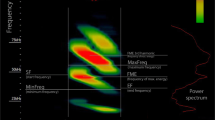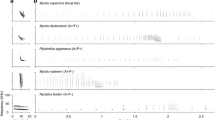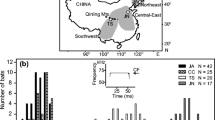Abstract.
We used both field and flight cage observations to investigate the echolocation and foraging behavior of the seldom studied, small, aerial insectivorous bat Myotis nigricans (Vespertilionidae) in Panama. In contrast to its temperate congeners, M. nigricans foraged extensively in open space and showed an echolocation behavior well adapted to this foraging habitat. It broadcast narrowband echolocation signals of 7 ms duration that enhance the chance of prey detection in open space. Because of rhythmical alternations of signal amplitude from signal to signal in our sound recordings of search signals in open space, we conclude that the bats scanned their environment with head movements, thereby enlarging their search volume. In edge-and-gap situations, and in the flight cage, M. nigricans introduced an initial broadband component to its search calls. In the field and in the flight cage, M. nigricans hawked for prey in aerial catches; gleaning was never observed. M. nigricans demonstrates call structures, such as narrow bandwidth and rather long signals adapted to foraging predominantly in open space. Moreover, call structure is highly plastic, allowing M. nigricans to forage in edge-and-gap situations also. These adaptations in call structure and plasticity have evolved convergently at least twice within the genus Myotis. Finally, M. nigricans echolocation and foraging behavior parallels that of the small, aerial, insectivorous pipistrelle bats (Vespertilionidae), which are not closely related to M. nigricans but forage in similar habitats.
Similar content being viewed by others
Author information
Authors and Affiliations
Additional information
Electronic Publication
Rights and permissions
About this article
Cite this article
Siemers, B.M., Kalko, E.K. & Schnitzler, HU. Echolocation behavior and signal plasticity in the Neotropical bat Myotis nigricans (Schinz, 1821) (Vespertilionidae): a convergent case with European species of Pipistrellus?. Behav Ecol Sociobiol 50, 317–328 (2001). https://doi.org/10.1007/s002650100379
Received:
Revised:
Accepted:
Issue Date:
DOI: https://doi.org/10.1007/s002650100379




